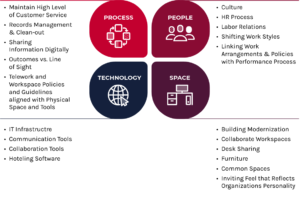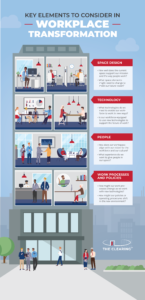“Workplace Project.”
It’s an amorphous term covering everything from renovations, construction, and moves to changing ways of working or implementing new technology. When we work with clients on any of these types of projects, we start by considering the impact on four areas that are key to workplace transformation: space; technology; people; and process/policies.
We’re careful to think of these areas as an ecosystem, not in isolation. Transform one and the others are impacted. Take a look at the visual below. It’s easy to see, for example, how changing culture could impact customer service or why shifting work styles may require a shift in technology.

Four Keys Areas of Workplace Transformation
How We Put These Keys into Practice
We use these four areas as a means to have four distinct conversations with our clients. This gets leaders thinking about critical questions for each of the four areas. Take these questions around Space, for example.

- How well does the current space support our people and mission?
- What might need to change to meet the future vision or to meet goals that have been set (i.e., better productivity, more collaboration, higher customer service scores, etc.)
We simply follow the map above and ask tailored questions about each area. It sounds cheesy, but I like to think of it as walking through a building and checking each floor, ensuring each one has exactly what we need to ensure a successful transformation.
After “walking the floors,” and asking our critical questions, we will have identified what must be included in our transformation. This knowledge is what equips us to build out an effective change management plan to meet our goals.
Tips for Utilizing the Four Keys Areas of Workplace Transformation
- Align leadership first – and stay aligned. Before beginning the transformation, it is essential that your leadership team is aligned on a shared vision for the future workplace and are prepared to communicate with one voice about the coming changes. If leaders aren’t in lock step, how can you expect your workforce to be onboard?
- Engage your workforce. It’s not only critical for you and your leadership cadre to be aligned on the answers to the key transformation questions, but for your workforce as well. Whether it is hosting focus groups or conducting employee surveys, getting their input may be the difference between an office design that facilitates desired levels of collaboration vs. one that leaves team members feeling isolated.
- Ask – then ask again. Workplace transformations are not set it and forget it. Once your transformation is underway, continue to look at things through the four key areas and ask those same questions. Observing changes in practice may shift some of the answers that were developed in theory. Always be ready to pause and consider optimization options if a proposed change isn’t having the desired effect.
- Communicate clearly. At every stage in the transformation process, clear and purposeful communication will help drive project buy-in and engagement. From the big stuff such as scope (i.e., these are the things we are considering as part of the transformation) to specific details about rollout (i.e., we might test out technology sooner than we see actual changes in our workspaces or we may pilot changes to processes and policies before moving into our brand-new space), keeping your stakeholders informed will result in a smoother transition for all.
If you are considering workplace changes, I’d love to “walk the floors” with you and help develop a strategy to get your organization where it wants to go. You can read more about The Clearing’s Workplace philosophy here or email me anytime at Kelly.barlow@theclearing.com.






 The Clearing’s Employee Experience
Improvement model, adapted from Itam
& Ghosh, 2020, focuses on three objectives:
The Clearing’s Employee Experience
Improvement model, adapted from Itam
& Ghosh, 2020, focuses on three objectives: 














